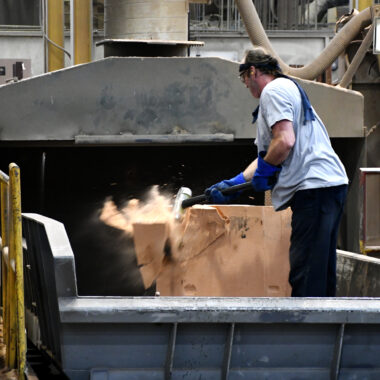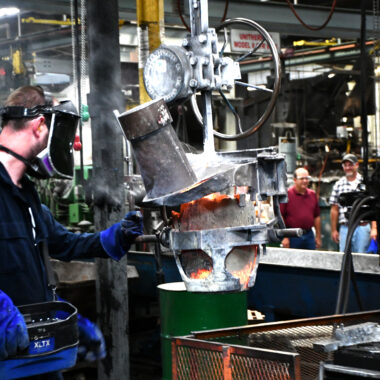Taking Full Advantage Of Effectiveness: Advanced Aluminum Casting Solutions Revealed
Taking Full Advantage Of Effectiveness: Advanced Aluminum Casting Solutions Revealed
Blog Article
The Top Methods for Light Weight Aluminum Spreading That You Need to Know
From the traditional sand spreading technique to the intricate investment spreading procedure, each technique supplies unique advantages that provide to various task requirements. As we navigate with the leading strategies for aluminum casting, it ends up being obvious that understanding these techniques is vital for attaining ideal results.
Sand Spreading Technique
The Sand Spreading Strategy is an essential method in aluminum casting, commonly made use of for its cost-effectiveness and adaptability in developing intricate steel shapes. This technique entails creating a mold and mildew constructed from compacted sand into which molten light weight aluminum is put, enabling it to take the shape and strengthen of the mold and mildew. One of the vital advantages of sand spreading is its capability to produce complicated geometries with relatively reduced tooling costs, making it an appealing option for makers looking to develop unique elements.
In the sand casting procedure, a pattern of the last part is pushed right into a fine sand blend contained within a flask. When the pattern is removed, a tooth cavity standing for the final part's form is left in the sand. Molten light weight aluminum is then poured right into the tooth cavity, taking and loading the space on the exact details of the pattern. After the aluminum cools down and strengthens, the sand mold is damaged away, revealing the newly cast aluminum component. Sand spreading is commonly used in different sectors, consisting of automotive, aerospace, and art factories, because of its capacity to produce both big and little steel parts with intricate designs.

Financial Investment Casting Process
An intricate technique employed in light weight aluminum casting is the Financial investment Casting Refine, understood for its capacity to create very outlined and detailed metal parts. Referred to as the lost-wax spreading process, this method dates back thousands of years and continues to be a prominent option in numerous industries due to its adaptability and accuracy.
The investment casting procedure starts with the creation of a wax pattern, which is coated with a ceramic covering to create a mold. The wax is then melted out, leaving a tooth cavity in the form of the wanted part. Molten aluminum is poured right into the ceramic mold and mildew, loading the tooth cavity and taking on the detailed information of the original wax pattern.
This method is favored for its capability to create intricate forms with excellent surface finish and dimensional accuracy. It is typically utilized in the manufacturing of aerospace parts, precious jewelry, and commercial machinery where complex designs are called for. The investment casting process offers high repeatability and can produce parts with minimal machining required, making it an economical selection for lots of applications.
Irreversible Mold And Mildew Approach
Employing a various technique from the Investment Casting Refine, the Permanent Mold and mildew Method in light weight aluminum spreading provides a distinctive method for creating steel elements. The heat transfer from the liquified metal to the mold and mildew assists in solidifying the light weight aluminum rapidly, lowering the cooling time contrasted to sand casting.
Among the essential benefits of the Long-term Mold And Mildew Technique is the improved surface coating and dimensional accuracy of the spreadings created. This method is likewise known for its capability to produce high-strength light weight aluminum components with constant top quality. Furthermore, the multiple-use nature of the mold makes it a cost-effective choice for tool to high volume manufacturing runs.
Pass Away Casting Modern Technology
Making use of advanced manufacturing processes, pass away casting modern technology presents an extremely effective approach for producing elaborate light weight aluminum parts. This strategy involves injecting molten aluminum right into a steel mold and mildew, called a die, at high stress. The die is specially developed to shape the aluminum right into the preferred kind, causing high accuracy and excellent surface finish.
Die casting offers several advantages. It enables the manufacturing of complicated shapes with thin wall surfaces, limited tolerances, Click Here and smooth surface areas, making it ideal for applications where aesthetic appeals and accuracy are vital. In addition, pass away spreading makes it possible for quick manufacturing prices, minimizing general production time and expenses.

Lost Foam Casting Technique
Die casting technology's efficiency and precision in producing light weight aluminum parts lead the means for checking out the Lost Foam Casting Technique as a complementary manufacturing strategy. Lost Foam Spreading, likewise understood as evaporative pattern casting, is a method that makes use of foam patterns to develop complex light weight aluminum parts.
One of the vital benefits of Lost Foam Casting is its ability to produce intricate go to website styles with detailed information that might be testing to accomplish through traditional spreading techniques. Furthermore, this technique removes the demand for cores, minimizes machining operations, and permits tighter resistances. Lost Foam Casting is specifically appropriate for small to medium-sized light weight aluminum components that require high accuracy and complex geometries. aluminum casting. As industries remain to demand light-weight yet long lasting components, Lost Foam Spreading verifies to be a valuable approach in the realm of light weight aluminum casting.
Conclusion
In verdict, understanding the top strategies for aluminum casting is critical for achieving high-grade cause the manufacturing procedure. Sand spreading, investment casting, long-term mold and mildew, die casting, and shed foam spreading are all reliable methods for creating light weight aluminum components with different levels of complexity. By grasping these strategies, manufacturers can guarantee that their products satisfy the wanted specifications and standards for performance and toughness.
From the typical sand casting method to the elaborate investment casting process, each method uses one-of-a-kind benefits that provide to various task needs.The Sand Spreading Technique is a fundamental method in aluminum casting, widely utilized for its cost-effectiveness and versatility in creating elaborate metal shapes. Lost Foam Casting, also recognized as evaporative pattern spreading, is an approach that makes use of foam patterns to develop complex light a fantastic read weight aluminum parts. As markets continue to demand light-weight yet sturdy parts, Lost Foam Spreading shows to be an important method in the realm of light weight aluminum spreading.
Sand casting, investment casting, irreversible mold and mildew, die casting, and shed foam casting are all reliable approaches for creating light weight aluminum components with various degrees of complexity.
Report this page